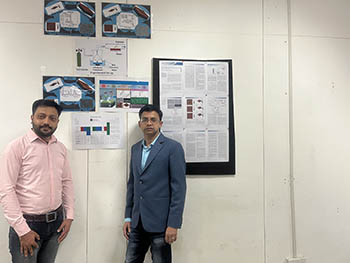MANDI: In a major breakthrough, the researchers at the Indian Institute of Technology Mandi have developed the "metal oxide layers for use in advanced architecture silicon solar cells" that can revolutionize the green Solar Industry in India.
This will give a new push to the India's plans to create an additional domestic solar equipment manufacturing capacity of 25 gigawatts (GW) each of solar cell.
India currently has a manufacturing capacity of 3GW for solar cells and 15GW for modules.
This new method has the potential to revolutionize the solar industry by reducing the cost and complexity of current production techniques.
Additionally, as the whole process including the equipment is developed in-house, the generated IP will contribute towards ATMANIRBHARTA in the area of advanced architecture silicon solar cells".
The results of this work is published in the journal of Materials Science: Materials in Electronics, co-authored by Dr Kunal Ghosh, Associate Professor, School of Computing and Electrical Engineering, IIT Mandi and his Ph.D scholars Mr. Syed Mohd Hussain and Mr. Md Sadullah from IIT Mandi.
Metal oxides such as nickel oxide are an important class of semiconductors used in advanced architecture silicon solar cells.
Nickel oxide films with thicknesses in the nanometre range – a hundred thousand times smaller than the width of a single human hair – must be produced for this purpose.
The current methods for developing nanometric thin films of nickel oxide are prohibitively expensive, as the equipment required for production has to be imported.
Additionally, the precursors used for the development of the films, such as nickel acetylacetonate, are also expensive, making it less likely for such technology to be commercially viable.
Dr Kunal Ghosh, IIT Mandi, said, “Aerosol-assisted chemical vapor deposition is a technique used to produce high-quality, uniform thin films on various surfaces, including silicon, by delivering a vapor phase precursor in the form of an aerosol.
The aerosol enables the deposition of a wide range of oxide based materials with high precision, making it a versatile and cost-effective method for various applications in materials science and engineering.”
Presently, the project is at Technology Readiness Level (TRL) 3, which means that it is still in the early stages of development.
However, with further development and increased TRL, this technology has the potential to be adopted by the industry.
This research will enhance the fabrication process of advanced architecture silicon photovoltaic devices, reducing the cost and complexity of commercial techniques.
Dr. Kunal Ghosh said, "Our research shows that it is possible to develop a cost-effective and scalable process for the production of metal oxide layers for solar cells'.




